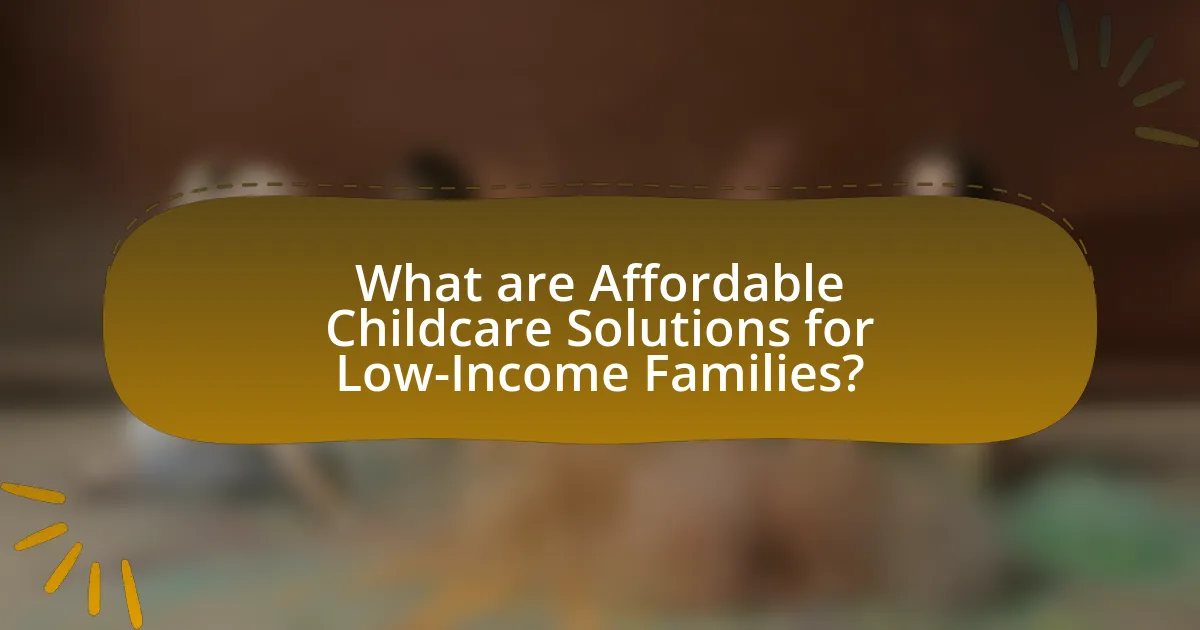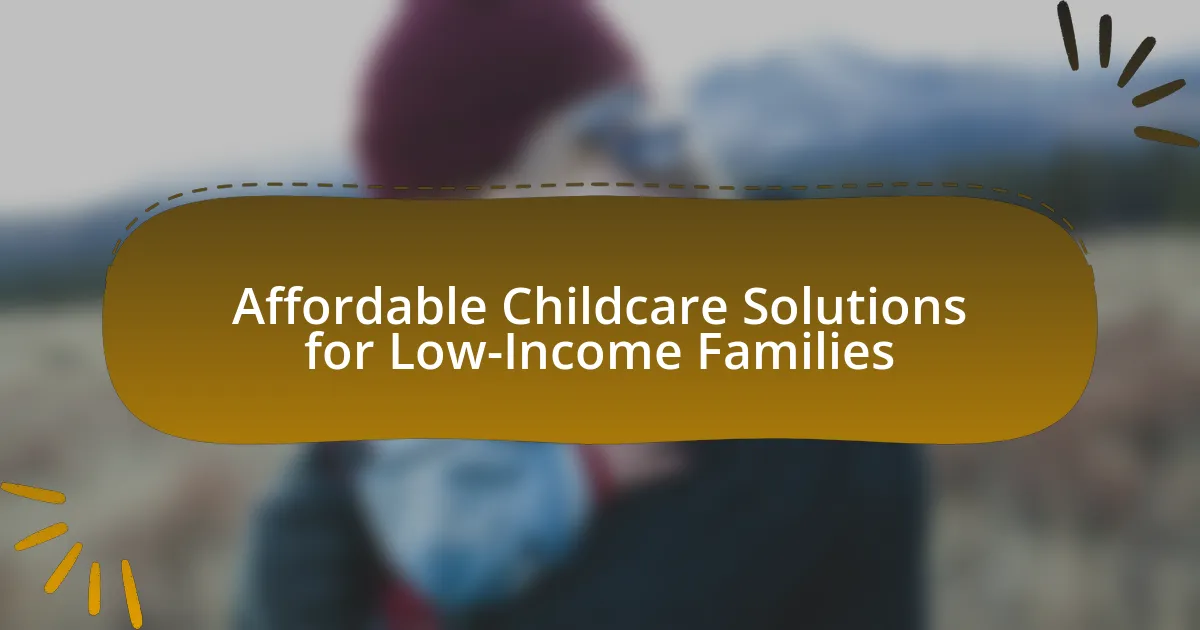Affordable childcare solutions for low-income families encompass various programs and initiatives designed to alleviate the financial burden of childcare. Key options include subsidized childcare programs, sliding scale fees based on income, and community-based cooperatives, which collectively enhance access to quality care. The article explores the specific challenges faced by low-income families in securing affordable childcare, the impact of these solutions on child development and parental employment, and the role of government and non-profit organizations in providing support. Additionally, it highlights practical strategies for families to find and utilize available resources effectively.

What are Affordable Childcare Solutions for Low-Income Families?
Affordable childcare solutions for low-income families include subsidized childcare programs, sliding scale fees based on income, and community-based childcare cooperatives. These options help reduce the financial burden on families by providing access to quality care at lower costs. For instance, the Child Care and Development Fund (CCDF) provides federal assistance to states, enabling them to offer subsidies to eligible low-income families, which can cover a significant portion of childcare expenses. Additionally, local non-profit organizations often establish cooperatives that allow families to share resources and costs, further enhancing affordability.
How do these solutions address the needs of low-income families?
Affordable childcare solutions directly address the needs of low-income families by providing accessible and affordable options for early childhood education and care. These solutions often include subsidized childcare programs, sliding scale fees based on income, and community-based initiatives that reduce costs. For instance, the Child Care and Development Fund (CCDF) in the United States allocates federal funds to states to support low-income families in accessing childcare, which has been shown to increase workforce participation among parents. Additionally, research indicates that affordable childcare can lead to improved developmental outcomes for children, thereby benefiting families economically and socially.
What specific challenges do low-income families face in accessing childcare?
Low-income families face significant challenges in accessing childcare, primarily due to high costs, limited availability, and inadequate support services. The average cost of childcare can consume a substantial portion of a low-income family’s budget, often exceeding 30% of their income, which makes it unaffordable. Additionally, many low-income neighborhoods lack sufficient childcare facilities, leading to long waiting lists and limited options. Furthermore, low-income families may struggle with inconsistent work hours or lack of transportation, complicating their ability to secure reliable childcare. These barriers are compounded by insufficient government assistance programs, which often do not meet the demand for affordable childcare solutions.
How do affordable solutions improve the quality of life for these families?
Affordable solutions significantly enhance the quality of life for low-income families by providing accessible childcare options that reduce financial strain. These solutions enable parents to pursue employment or education opportunities, leading to increased household income and improved economic stability. Research indicates that affordable childcare can increase workforce participation among parents by up to 60%, allowing families to break the cycle of poverty. Furthermore, affordable childcare promotes children’s development and well-being, as it often includes educational components that prepare them for future academic success. This dual benefit of economic and developmental support illustrates how affordable childcare solutions are crucial for improving the overall quality of life for these families.
What types of affordable childcare solutions exist?
Affordable childcare solutions include subsidized daycare programs, family childcare networks, cooperative childcare arrangements, and flexible work schedules that allow parents to share childcare responsibilities. Subsidized daycare programs often receive funding from government sources, making them accessible to low-income families. Family childcare networks connect families with local caregivers who offer services at lower rates. Cooperative childcare arrangements involve groups of parents sharing childcare duties, reducing costs significantly. Flexible work schedules enable parents to coordinate care among themselves, further alleviating financial burdens. These solutions are designed to address the financial challenges faced by low-income families while ensuring quality care for children.
What are the differences between subsidized and free childcare programs?
Subsidized childcare programs provide financial assistance to families to help cover the costs of childcare, while free childcare programs offer services at no cost to families. In subsidized programs, families typically pay a portion of the childcare fees based on their income, and the government or other organizations cover the remaining costs. In contrast, free childcare programs do not require any payment from families, making them fully accessible regardless of income. According to the U.S. Department of Health and Human Services, subsidized programs often have eligibility criteria based on income levels, whereas free programs may be available to all families within certain age or enrollment limits.
How do community-based childcare initiatives operate?
Community-based childcare initiatives operate by providing accessible and affordable childcare services tailored to the needs of local families. These initiatives often involve collaboration among local organizations, government agencies, and community members to create programs that address specific challenges faced by low-income families, such as high childcare costs and limited availability of services. For example, a study by the National Women’s Law Center highlights that community-based programs can reduce childcare expenses by offering sliding scale fees based on income, thereby making childcare more affordable for families in need.
Why is affordable childcare important for child development?
Affordable childcare is crucial for child development because it ensures that children have access to quality early education and socialization opportunities. Research indicates that children who attend high-quality childcare programs demonstrate better cognitive and social skills, which are foundational for future learning and development. For instance, a study by the National Institute of Child Health and Human Development found that children in affordable, high-quality childcare settings scored higher on measures of school readiness compared to those without such access. This highlights the importance of affordable childcare in fostering essential developmental milestones during early childhood.
What role does early childhood education play in a child’s future?
Early childhood education significantly influences a child’s future by laying the foundation for cognitive, social, and emotional development. Research indicates that children who participate in quality early childhood education programs demonstrate improved academic performance, higher graduation rates, and better social skills compared to those who do not. For instance, a study by the National Institute for Early Education Research found that children enrolled in high-quality preschool programs are 40% more likely to graduate from high school. This early educational experience equips children with essential skills that contribute to lifelong learning and success.
How does access to affordable childcare impact parental employment?
Access to affordable childcare significantly increases parental employment rates. When childcare is affordable, parents, particularly mothers, are more likely to enter the workforce or increase their working hours. A study by the National Women’s Law Center found that access to affordable childcare can boost employment rates among single mothers by up to 30%. This correlation is due to the reduction of financial strain and the ability to secure reliable care for children, allowing parents to pursue job opportunities without the burden of high childcare costs.
How can families find affordable childcare solutions?
Families can find affordable childcare solutions by exploring local government assistance programs, community resources, and flexible work arrangements. Many states offer subsidies for low-income families, which can significantly reduce childcare costs. For instance, the Child Care and Development Fund (CCDF) provides financial assistance to eligible families, helping them access quality care. Additionally, community organizations often provide resources or referrals to affordable childcare options. Families can also consider co-op childcare arrangements, where parents share caregiving responsibilities, thereby lowering costs. Research indicates that utilizing these resources can lead to substantial savings, making childcare more accessible for low-income families.
What resources are available for low-income families seeking childcare?
Low-income families seeking childcare can access several resources, including government assistance programs, nonprofit organizations, and community initiatives. The Child Care and Development Fund (CCDF) provides financial assistance to eligible families, helping them afford childcare services. Additionally, local Head Start programs offer free or low-cost early childhood education and care for children from low-income families. Nonprofit organizations, such as the YMCA and local community centers, often provide subsidized childcare options and support services. According to the U.S. Department of Health and Human Services, these resources aim to improve access to quality childcare for families in need, ensuring that children receive essential early learning opportunities.

What government programs support affordable childcare for low-income families?
The Child Care and Development Fund (CCDF) is a primary government program that supports affordable childcare for low-income families. CCDF provides financial assistance to eligible families to help cover the costs of childcare, enabling parents to work or attend school. In 2021, the program allocated approximately $5.8 billion to assist over 1.5 million children, demonstrating its significant impact on improving access to affordable childcare for low-income households. Additionally, the Head Start program offers comprehensive early childhood education, health, and nutrition services to low-income children and their families, further supporting affordable childcare solutions.
How do federal and state programs differ in their support?
Federal and state programs differ in their support for affordable childcare solutions primarily in funding sources and eligibility criteria. Federal programs, such as the Child Care and Development Fund (CCDF), provide block grants to states, which are then used to subsidize childcare costs for low-income families, typically with broader eligibility requirements. In contrast, state programs often have more specific criteria, including income limits and age restrictions for children, and may vary significantly in the amount of financial assistance offered. For instance, while the federal CCDF allocates approximately $5.8 billion annually, individual states may choose to supplement this funding with their own resources, leading to disparities in support levels and accessibility across different regions.
What are the eligibility requirements for these programs?
The eligibility requirements for affordable childcare solutions for low-income families typically include income thresholds, residency status, and age of the child. Families must generally have an income at or below a certain percentage of the federal poverty level, which varies by state and program. Additionally, applicants usually need to be residents of the state where they are applying and have children who are typically under the age of 13. These criteria ensure that assistance is directed to those who need it most, as outlined in various state and federal guidelines for childcare assistance programs.
How can families apply for government assistance in childcare?
Families can apply for government assistance in childcare by visiting their state’s child care assistance program website or contacting their local social services office. Each state administers its own program, which typically requires families to provide information about their income, household size, and the type of childcare needed. For example, the U.S. Department of Health and Human Services reports that the Child Care and Development Fund (CCDF) provides financial assistance to low-income families to help cover childcare costs, ensuring access to affordable care.
What role do non-profit organizations play in providing affordable childcare?
Non-profit organizations play a crucial role in providing affordable childcare by offering subsidized services and financial assistance to low-income families. These organizations often receive funding from government grants, private donations, and community partnerships, enabling them to reduce childcare costs significantly. For instance, according to the National Association of Child Care Resource & Referral Agencies, non-profits can lower fees by up to 50% compared to for-profit childcare providers, making essential services accessible to families in need. Additionally, non-profits frequently implement programs that enhance the quality of care, such as training for childcare providers and educational resources for parents, further supporting the well-being of children and families.
How do non-profits collaborate with local governments to enhance childcare access?
Non-profits collaborate with local governments to enhance childcare access by forming partnerships that leverage resources, expertise, and community outreach. These collaborations often involve non-profits providing direct services, such as childcare programs, while local governments contribute funding, policy support, and infrastructure. For instance, in many regions, non-profits work with local governments to secure grants that fund childcare initiatives, thereby increasing the availability of affordable options for low-income families. Additionally, non-profits may assist in implementing government policies aimed at expanding childcare access, ensuring that services meet community needs effectively. This synergy not only improves service delivery but also fosters a comprehensive approach to addressing childcare challenges in the community.
What specific programs have been successful in supporting low-income families?
The Supplemental Nutrition Assistance Program (SNAP) has been successful in supporting low-income families by providing essential food assistance. In 2021, SNAP served approximately 41 million individuals, helping to alleviate food insecurity among low-income households. Additionally, the Temporary Assistance for Needy Families (TANF) program has effectively provided cash assistance and support services to low-income families, with over 1.5 million families receiving benefits in 2020. These programs demonstrate a significant impact on improving the well-being of low-income families through direct financial support and access to necessary resources.

What are the challenges in implementing affordable childcare solutions?
The challenges in implementing affordable childcare solutions include funding constraints, regulatory barriers, and workforce shortages. Funding constraints arise as governments and organizations often struggle to allocate sufficient resources to subsidize childcare costs, limiting accessibility for low-income families. Regulatory barriers can complicate the establishment of new childcare facilities, as compliance with licensing requirements and safety standards can be costly and time-consuming. Additionally, workforce shortages in the childcare sector hinder the ability to provide quality care, as low wages and poor working conditions lead to high turnover rates among childcare providers. According to a report by the National Association for the Education of Young Children, nearly 50% of childcare centers reported difficulty in hiring qualified staff, which directly impacts the availability of affordable options for families.
What barriers do providers face in offering affordable services?
Providers face significant barriers in offering affordable childcare services, primarily due to funding constraints, regulatory requirements, and operational costs. Funding limitations restrict the ability of providers to lower fees while maintaining quality services. For instance, many childcare providers rely on government subsidies, which may not cover the full cost of care, leading to financial strain. Regulatory requirements, such as staff-to-child ratios and safety standards, increase operational costs, making it challenging to offer lower prices. According to a report by the National Association of Child Care Resource & Referral Agencies, nearly 60% of childcare providers operate at a loss, highlighting the financial difficulties in providing affordable services.
How does funding impact the availability of affordable childcare?
Funding directly influences the availability of affordable childcare by determining the resources allocated to childcare programs and subsidies. Increased funding allows for the expansion of childcare services, enabling providers to lower fees and improve quality. For instance, a report from the National Women’s Law Center indicates that states with higher childcare funding have more accessible and affordable options for low-income families, as they can offer subsidies that reduce out-of-pocket costs. Conversely, insufficient funding leads to higher fees and fewer available slots, limiting access for families in need.
What are the implications of regulatory requirements on childcare affordability?
Regulatory requirements significantly impact childcare affordability by increasing operational costs for providers, which can lead to higher fees for families. For instance, regulations regarding staff-to-child ratios, safety standards, and staff qualifications necessitate additional hiring and training, raising overall expenses. According to a report by the National Association of Child Care Resource & Referral Agencies, these increased costs can result in childcare fees that are unaffordable for low-income families, exacerbating financial strain. Furthermore, stringent regulations may limit the number of available childcare providers, reducing competition and keeping prices elevated.
How can communities advocate for better childcare solutions?
Communities can advocate for better childcare solutions by organizing grassroots campaigns that raise awareness about the need for affordable childcare options. These campaigns can include community meetings, petitions, and partnerships with local organizations to highlight the challenges faced by low-income families. Research indicates that communities with active advocacy efforts, such as the “Child Care Aware of America” initiative, have successfully influenced policy changes that expand access to affordable childcare services. By mobilizing residents and leveraging local resources, communities can effectively push for legislative reforms and funding allocations that support childcare initiatives.
What strategies can families use to influence local childcare policies?
Families can influence local childcare policies by organizing advocacy groups to collectively voice their needs and concerns. These groups can engage in activities such as attending town hall meetings, where they can present data on the importance of affordable childcare, highlighting that access to quality childcare is linked to improved child development outcomes and economic stability for families. Additionally, families can collaborate with local organizations to conduct surveys that gather community input on childcare needs, which can be presented to policymakers to demonstrate the demand for affordable options. Research shows that community engagement in policy advocacy can lead to more responsive local governance, as seen in initiatives like the “Child Care for Working Families Act,” which emphasizes the role of community voices in shaping childcare policy.
How can community engagement improve childcare options for low-income families?
Community engagement can significantly improve childcare options for low-income families by fostering collaboration among local organizations, parents, and service providers. This collaboration can lead to the development of community-based childcare programs that are tailored to the specific needs of low-income families, ensuring accessibility and affordability. For instance, initiatives such as cooperative childcare models, where parents share caregiving responsibilities, have been shown to reduce costs and increase availability. Additionally, community engagement can mobilize resources and funding from local businesses and government entities, enhancing the quality and reach of childcare services. Research indicates that communities with strong engagement efforts see a 20% increase in the availability of affordable childcare options, demonstrating the effectiveness of collective action in addressing this critical issue.
What practical tips can low-income families use to secure affordable childcare?
Low-income families can secure affordable childcare by exploring local subsidies, community programs, and flexible work arrangements. Many states offer childcare assistance programs that can significantly reduce costs; for instance, the Child Care and Development Fund provides financial aid to eligible families. Additionally, local non-profits and community organizations often have resources or partnerships with childcare providers to offer reduced rates. Families can also consider co-op childcare arrangements, where parents share caregiving responsibilities, thus lowering individual costs. Research indicates that utilizing these resources can lead to substantial savings, making childcare more accessible for low-income households.
